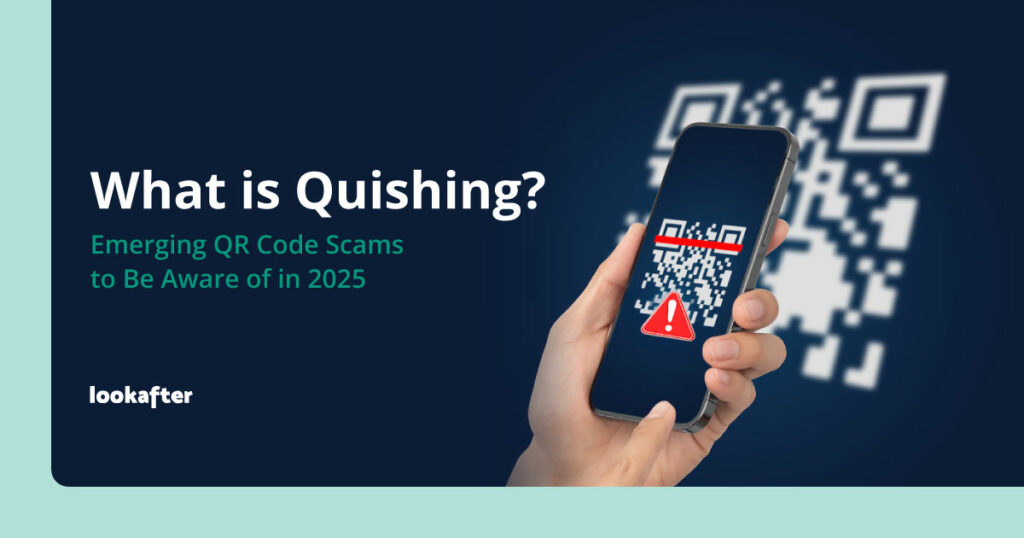Home > Empowering Tips > What is Quishing? An emerging scam to be aware of

Imagine this: You’re at a coffee shop and see a poster advertising a free drink for completing a quick survey. You scan the QR code on the poster with your phone, expecting to be redirected to a feedback form. Instead, you’re taken to a fake login page mimicking a popular social media site. Without realizing it, you enter your credentials, handing over your personal information to a scammer. What happened? You just fell victim to Quishing, a sneaky cyberattack that uses fake QR codes to steal sensitive information.
What is Quishing?
Quishing, derived from “QR Code” and “phishing”, is a cyberattack where scammers use malicious QR codes to redirect users to fraudulent websites or download harmful software. Unlike traditional phishing, which relies on deceptive emails or links, quishing leverages the trust people have in QR codes — often found in ads, restaurant menus, and payment systems.
How Quishing Works?
QR codes are widely used for quick access to websites, making payments, or logging into apps. Unfortunately, attackers exploit this convenience by embedding fraudulent links within QR codes, leading unsuspecting users to fake login pages or malicious downloads.
In a typical Quishing attack, the attacker first creates a malicious QR code that points to a phishing site or malware-infected page. This code is then distributed through various means such as emails, posters, business cards, or fake advertisements.
When an unsuspecting user scans the QR code, believing it leads to a legitimate destination, they are redirected to a counterfeit site. There, they might be prompted to enter personal information such as login credentials, credit card numbers, or other sensitive data. In some cases, the code may also initiate a malware download, compromising the user’s device and potentially granting attackers access to more information.
Examples of Quishing Attacks
Fake Login Page
Attackers embed a QR code in an email claiming to be from a trusted organization — like a bank or office IT team — asking the recipient to scan it for urgent account verification. Once scanned, it leads to a fake login page designed to steal credentials.
Physical Flyer or Poster Scam
Fraudulent QR codes are printed on posters promoting special offers, discounts, or giveaways. These are placed in high-traffic areas like cafes, public transport stops, or restrooms. When scanned, users are redirected to malicious websites.
Compromised Business Cards
QR codes printed on fake or altered business cards link to malicious sites. These cards may be left at events, on bulletin boards, or even handed out at networking functions.
Fake Payment Portals
Scammers place QR code stickers on top of legitimate payment codes (like on parking meters or restaurant tables). When scanned, these codes redirect to phishing websites that mimic payment gateways and steal credit card information.
Event Check-In Scams
Fake event invitations or registration booths offer QR codes for check-in or freebies. When scanned, the code leads to login forms mimicking event platforms, social media logins, or survey pages designed to collect sensitive data.
Why Quishing Tricks So Many Users?
Quishing tricks so many users because it preys on the seamless and routine experience of scanning QR codes — something users do regularly without second thought. QR codes are visual and non-transparent, meaning users cannot see the actual URL or destination until it’s too late. Unlike traditional phishing, where users might recognize a suspicious link in an email, a QR code hides that link behind a simple black-and-white pattern. Furthermore, smartphones — the primary devices used to scan QR codes — often have limited visibility and fewer security warnings than desktop browsers. These factors, combined with the increasing popularity of contactless interactions and the widespread trust in QR codes across industries, make Quishing a deceptively effective attack vector.
How to Protect Yourself from Quishing
- Verify QR Codes Before Scanning: If a QR code comes from an email or flyer, confirm its authenticity before scanning.
- Use a QR Code Scanner with Security Features: Some QR scanners display the link before opening it, allowing users to inspect URLs.
- Avoid Scanning QR Codes from Unknown Sources: Be cautious of scanning QR codes found in public places, unexpected locations, or received through unsolicited messages.
- Check the URL Before Logging In: After scanning, review the website URL for misspellings or suspicious domains.
- Manually Enter URLs: If a QR code suggests visiting a site, manually type the URL instead of scanning.
- Enable Multi-Factor Authentication (MFA): Even if credentials are stolen, MFA provides an additional security layer to prevent unauthorized access.
Conclusion
Quishing is a growing cybersecurity threat that preys on the convenience of QR codes. By staying vigilant and following best practices, individuals and businesses can reduce the risk of falling victim to such attacks. Always verify QR codes before scanning, use secure authentication methods, and educate yourself on emerging phishing techniques to stay ahead of cyber threats.